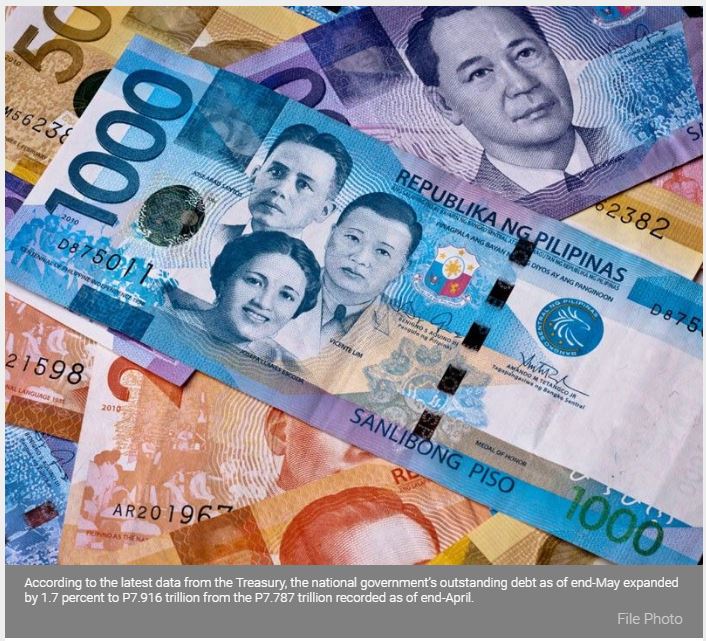Philippines: Government debt swells to P7.9 T in May, a new record high
MANILA, Philippines — The national government’s debt pile rose to another record high of P7.916 trillion in May following the country’s return to the European and Chinese debt markets, the Bureau of the Treasury (BTr) reported yesterday.
According to the latest data from the Treasury, the national government’s outstanding debt as of end-May expanded by 1.7 percent to P7.916 trillion from the P7.787 trillion recorded as of end-April.
The BTr attributed the increase to the net issuance of both domestic and foreign loans, as well as foreign exchange fluctuations.
Since the beginning of the year, the country’s debt stock increased by 8.5 percent or P623.03 billion from the end-2018 level of P7.29 trillion.
The government borrows from both domestic and external lenders to plug the expected deficit in its budget, which is capped at 3.2 percent of the gross domestic product (GDP) this year.
Treasury data showed that the bulk or 66.4 percent of the total debt stock as of May 31 was borrowed domestically, while the remaining 33.6 percent was sourced from foreign creditors.
The country’s external debt stock saw higher growth during the period, increasing by three percent to reach P2.659 trillion from the P2.581 trillion recorded as of end-April.
“For the month, higher external debt can be attributed to the effect of currency fluctuations of both dollar and third-currency denominated debt amounting to P6.14 billion and P10.09 billion, respectively,” the Treasury said.
“At the same time, net availment of foreign loans amounted to P61.48 billion, including 750 million euros in Euro bonds as part of the national government’s effort to diversify funding sources for infrastructure investment and human capital development,” it said.
The Philippines returned to the European debt market in early May, raising 750 million euros from the issuance of eight-year global bonds.
The debt papers were priced at a coupon rate of 0.875 percent, 70 basis points over benchmark. This yield is also tighter than the initial pricing guidance of plus 90 to 100 basis point range.
A week after, the Philippines also tapped the Chinese onshore market, issuing 2.5 billion renminbi-denominated panda bonds with a three-year tenor.
The securities fetched a coupon rate of 3.58 percent, translating to a tight spread which is 32 basis points above the benchmark.
Meanwhile, Treasury data also showed that domestic debt as of end-May climbed by one percent to P5.256 trillion from P5.205 in the previous month.
“The higher level for May was caused by net issuance of government securities amounting to P50.95 billion, which added to the P60 million revaluation of onshore dollar bonds due to peso depreciation,” the BTr said.
Guaranteed obligations of the national government also inched up by 0.7 percent to P486.16 billion as of end-May from P482.98 billion in the previous month, according to the Treasury.
“The increment in guarantees was due to the net issuance of domestic guarantees amounting to P49.72 billion and the impact of net appreciation of both the US dollar and third-currency denominated guarantees amounting to P680 million and P3.68 billion, respectively,” the bureau said.
However, this was tempered by the net repayment of foreign guarantees amounting to P50.85 billion.
For 2019, the national government is programmed to borrow P1.19 trillion, 20 percent higher than last year’s borrowing program of P986 billion.
Of the amount, P297.2 billion ($5.504 billion) is expected to come from foreign lenders, while the remaining P891.7 billion would be borrowed from domestic creditors.
Source: https://www.philstar.com/business/2019/07/04/1931721/government-debt-swells-p79-t-may-new-record-high#YI3tHLdgG6fR5wif.99


 English
English




